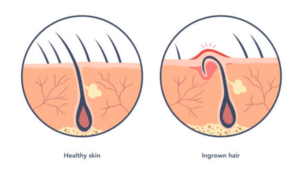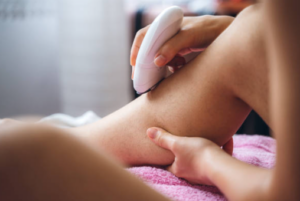Ingrown Hair SOS

Few things can ruin the joy of smooth, hair-free skin like the pesky presence of ingrown hairs. Whether they appear after shaving, waxing, or tweezing, ingrown hairs can be painful, unsightly, and downright frustrating to deal with. But fear not! In this beauty blog, we’ll explore effective strategies for treating and preventing ingrown hairs, so you can enjoy the silky-smooth skin you deserve. From gentle exfoliation techniques to proper hair removal methods, we’ll cover everything you need to know to banish ingrown hairs for good.
Before we delve into treatment and prevention strategies, let’s take a closer look at what ingrown hairs are and why they occur. Ingrown hairs occur when a hair follicle becomes trapped beneath the surface of the skin, causing it to grow sideways or curl back into the skin instead of emerging from the follicle. This can lead to inflammation, redness, and the formation of small, painful bumps known as razor bumps or ingrown hairs.
Common Causes of Ingrown Hairs
Several factors can contribute to the development of ingrown hairs, including:
- Improper Hair Removal Techniques: Shaving, waxing, and tweezing can disrupt the natural growth pattern of hair follicles, increasing the likelihood of ingrown hairs.
- Tight Clothing: Wearing tight clothing, especially in areas prone to ingrown hairs such as the bikini line or underarms, can trap hairs and exacerbate ingrown hair formation.
- Dry or Dead Skin Cells: Build-up of dry or dead skin cells can block hair follicles and prevent hairs from growing outward, leading to ingrown hairs.
- Curly or Coarse Hair: Individuals with curly or coarse hair are more prone to ingrown hairs, as the hair may be more likely to curl back into the skin instead of growing outward.
- Friction: Friction from activities such as exercise or rubbing against clothing can irritate the skin and contribute to ingrown hair formation.
Treatment Strategies for Ingrown Hairs
If you’re dealing with ingrown hairs, there are several effective treatment strategies you can try to alleviate discomfort and promote healing:
- Gentle Exfoliation
Regular exfoliation can help remove dead skin cells and unclog hair follicles, allowing trapped hairs to break free. Use a gentle exfoliating scrub or a washcloth to exfoliate the affected area 2-3 times per week, being careful not to scrub too aggressively to avoid further irritation.
- Warm Compress
Applying a warm compress to the affected area can help soothe inflammation and encourage ingrown hairs to surface. Simply soak a clean washcloth in warm water, wring out excess moisture, and apply it to the skin for 5-10 minutes.
- Topical Treatments
Over-the-counter topical treatments containing ingredients such as salicylic acid, glycolic acid, or benzoyl peroxide can help exfoliate the skin and reduce inflammation associated with ingrown hairs. Apply the treatment directly to the affected area according to the product instructions.
- Avoid Picking or Scratching
As tempting as it may be, avoid picking or scratching at ingrown hairs, as this can lead to further irritation, infection, and scarring. Instead, allow the ingrown hair to resolve on its own or seek professional assistance if necessary.
- Moisturize
Keeping the skin well-hydrated with a gentle, non-comedogenic moisturizer can help prevent dryness and irritation that can exacerbate ingrown hairs. Choose a moisturizer that is free of fragrances and other potential irritants.
- Seek Professional Help
If ingrown hairs persist or become infected, consider seeking professional help from a dermatologist or licensed esthetician. They can provide targeted treatments such as laser hair removal or corticosteroid injections to help alleviate symptoms and prevent future ingrown hairs.

Prevention Strategies for Ingrown Hairs
Preventing ingrown hairs starts with adopting proper hair removal techniques and skincare practices to minimize the risk of irritation and inflammation:
- Choose the Right Hair Removal Method: Opt for hair removal methods that are gentle on the skin, such as shaving with a sharp razor, using a moisturizing shaving cream or gel, or opting for professional waxing or laser hair removal treatments.
- Exfoliate Regularly: Incorporate regular exfoliation into your skincare routine to help prevent the build-up of dead skin cells and unclog hair follicles. Use a gentle exfoliating scrub or a washcloth to exfoliate the skin 2-3 times per week.
- Shave in the Direction of Hair Growth: When shaving, always shave in the direction of hair growth to minimize the risk of ingrown hairs. Avoid shaving too closely or against the grain, as this can increase the likelihood of irritation and ingrown hairs.
- Moisturize Daily: Keep the skin well-hydrated with a gentle, non-comedogenic moisturizer to prevent dryness and irritation that can contribute to ingrown hair formation. Apply moisturizer to the skin immediately after shaving or hair removal to lock in hydration.
- Wear Loose-Fitting Clothing: Avoid wearing tight clothing, especially in areas prone to ingrown hairs such as the bikini line or underarms, as tight clothing can trap hairs and exacerbate ingrown hair formation.
- Consider Professional Treatments: If you struggle with ingrown hairs despite following preventive measures, consider seeking professional treatments such as laser hair removal or electrolysis to permanently reduce hair growth and minimize the risk of ingrown hairs.
Dealing with ingrown hairs can be frustrating, but with the right treatment and prevention strategies, you can achieve smooth, bump-free skin. Whether you’re exfoliating regularly, using topical treatments, or seeking professional help, there are plenty of options available to help alleviate discomfort and promote healing. By adopting proper hair removal techniques and skincare practices, you can banish ingrown hairs for good and enjoy the silky-smooth skin you deserve. Remember to be patient and consistent with your efforts, and don’t hesitate to seek professional assistance if needed. Here’s to smooth, bump-free skin and newfound confidence!

